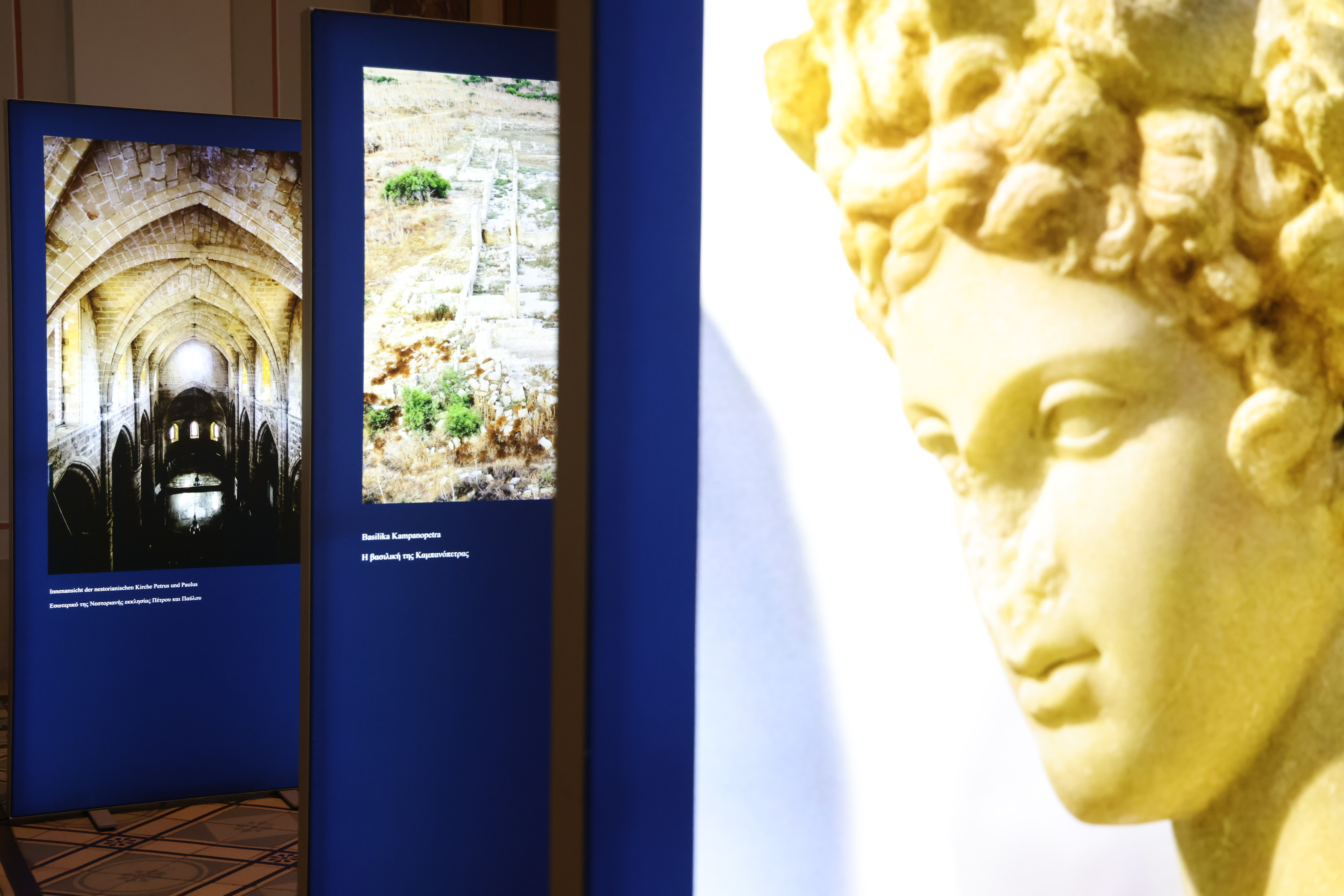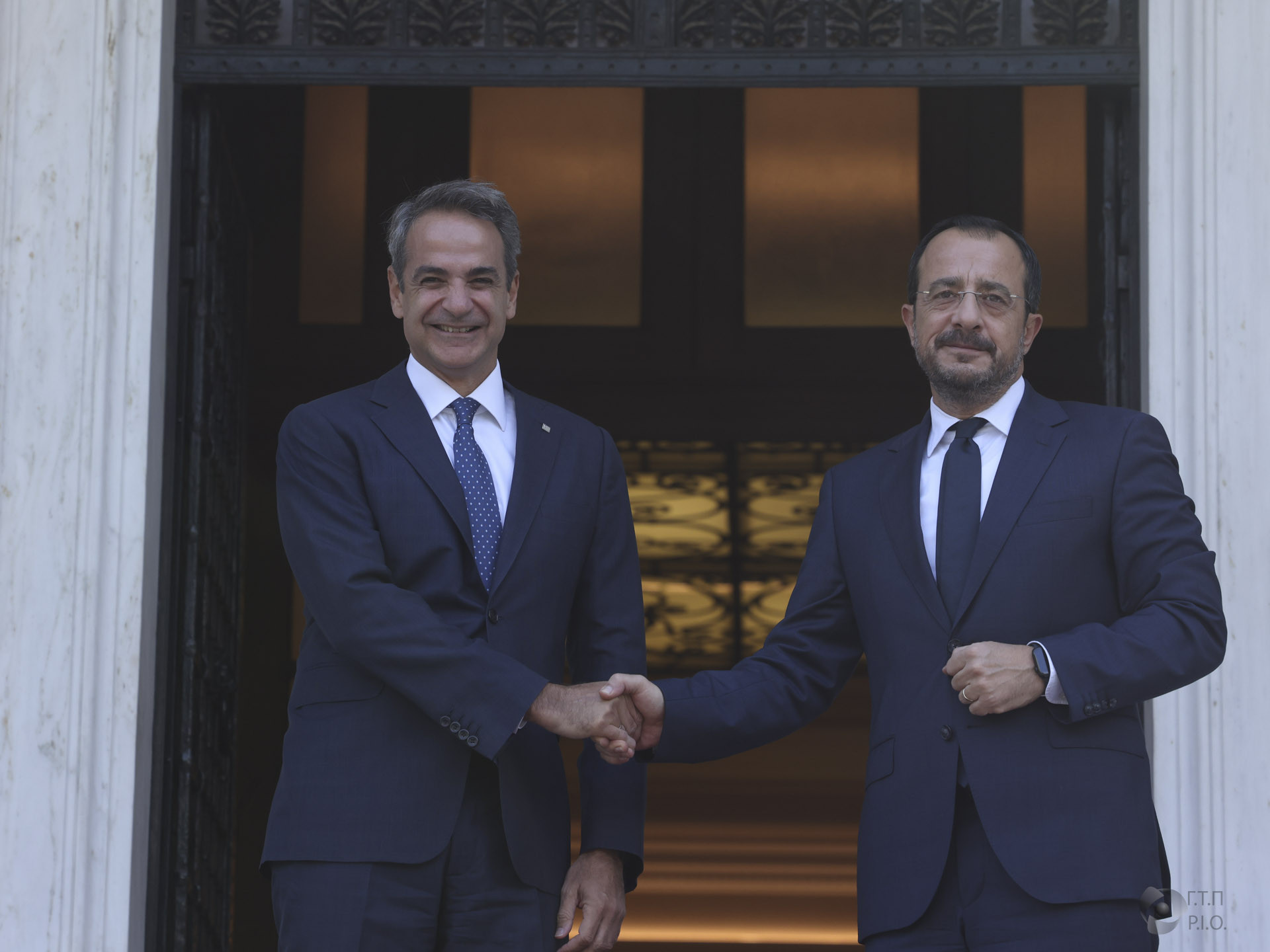The history of the key and heart of Cyprus
Source: Cyprus Mail
Three volumes about a city totalling more than a thousand pages may appear over-long but not when it covers 37 centuries of history, starting from 1600BC.
The three-volume work, titled Walking in the Κingdom of Salamina (Περπατώντας στο Βασίλειο της Σαλαμίνας), looks at 37 centuries of civilization in Ammochostos, which in English is referred to as Famagusta.
It is written by Ammochostos born and bred historian Anna Marangou, who presented the trilogy at the University of Vienna 10 days ago, in an event under the auspices of Interior Minister Constantinos Ioannou organised by the Cyprus Cultural Centre of Vienna and the Press and Information Office (PIO).
The PIO also organised a photographic exhibition at the same venue, featuring some of the pictures in the three-tome book, taken by Petros Fiakkas and Giorgos Kladis.
Many would wonder why a book dedicated to Ammochostos has a reference to Salamina in its title, said Marangou, who explained: “Ammochostos is Salamina. Salamina is the continuation, the evolution of three other cities in the same area – prehistoric Engomi, Arsinoe of the Ptolemies and the subsequent Byzantine Constantia, our then capital.”
Marangou has no doubt about the reason for the pre-eminence of the eastern-most part of the island, which from the dawn of our history, saw the evolution of cities with a novel culture that “is owed to the biggest gift the Gods gave the island – copper.”
Prehistoric Engomi was a city state built to serve the trade of copper that was found in the Troodos mountain range. It was built by the Achaeans and Aegeopelagites that were visiting the island as early as the 16th century BC, settling here in the 12th century.
Engomi, with its settlements, its port, its wall was the first picture of an urban centre, competing with bigger neighbouring civilizations. What was remarkable, according to Marangou, was that this city state of the Bronze Age, was capable of administering the mining and export of copper in large quantities. It was the oldest ‘state’ of the island, exercising control over the rest of Cyprus, but almost nothing of it is left today.

Presentation event of Anna Marangou’s trilogy “Walking through the Kingdom of Salamis”
University of Vienna, Vienna, Republic of Austria
Presentation event of Anna Marangou’s trilogy “Walking through the Kingdom of Salamis”, jointly organised by the Press and Information Office of the Republic of Cyprus and the Cyprus Cultural Centre in Vienna, at the University of Vienna, under the auspices and in the presence of the Minister of the Interior of the Republic of Cyprus, Mr Constantinos Ioannou.
Destroyed, probably by earthquakes, its inhabitants moved eastwards towards the sea, where they built Salamina of Cyprus. Popular myth suggests that it was built by Tefkros, the brother of Aiantas, when he returned from the Trojan War so it could remind him of Greece’s Salamina. Such was the prosperity copper brought that King Evagoras was in the position to try to unite the 10 kingdoms established in Cyprus. The big powers of the time – the Assyrians, Egyptians, Persians – also wanted the copper and Salamina came under their control at different times.
While Alexander the Great never stopped in Cyprus his successors did, and the Ptolemies renamed it Arsinoe, in honour of the wife and sister of the king. They also built a new port as well as palaces and temples dedicated to Zeus.
During the Roman domination and Pax Romana, the Romans of Salamina, said Marangou, “lived a luxury life with gymnasia, theatres, stadiums, villas with statues, marble columns, mosaics and frescos while at the much-vaunted port products from the East arrived and the goods of the Cypriot earth departed.” When the Roman empire was divided, Cyprus became part of the east Empire and belonged to Antioch while Paul and Barnabas settled in Salamina to teach the new religion.
After two devastating earthquakes flattened Salamina in the fourth century AD, the Byzantine Emperor Constantios undertook to rebuild the city and named it Constantia. A new port was built and Salamina/Constantia became the capital of the country. These glory days were marred by the Arab raids from the 7th century to the 10th, raids that destroyed many of the Constantia’s landmarks.
When Jerusalem was taken by the Arabs in 1187 it had a big impact on the course of Cyprus’ eastern coast, said Marangou, as Europe had a lucrative East-West trade. This sparked the start of the crusades to free the Holy Land, while the merchants of Europe moved away from Syria-Palestine and settled in Constantia, which had a port well protected from the north winds.
In the third crusade, Richard the Lionheart defeated the Byzantine emperor of Cyprus and eventually sold the island to the French nobleman Guy of Lusignan, husband of Queen Sibylla of Jerusalem. In 1192 Cyprus was under the Lusignans and with the approval of the Holy Roman Empire it became a kingdom with Lefkosia as its capital. Ammochostos, however, remained the important trading post, “the key and heart of Cyprus.”
Marangou said that between the 13th and 15th centuries, Ammochostos became a “centre of transit trade that united East and West, and while the Pope had forbidden Europeans trading with Arab ports, the Cypriots took advantage of this embargo, buying and transferring to Ammochostos all the goods from the East needed in the West.”
In this period the city became very wealthy, with one German traveller by the name of Ludolf von Suchen writing in 1338 saying that “I dare not speak about their riches.” There were palaces, squares, cathedrals, churches (according to lore there were 365 churches, one for each day) but the port was the heart of the city. The majority of inhabitants were Greek Orthodox but there were also European merchants, and people from the East including Nestorians, Melchites, Armenians, Jews and Maronites.
For 91 years, Genoa had control of Ammochostos, the island was subsequently attacked by the Mamelukes from Egypt who take over Cyprus and set it ablaze, destroying among other things the palace of Ammochostos. Venice, the biggest naval power of the Mediterranean at the time, recognising the geographical importance of Cyprus took complete control of the island in 1489. The Captain of Ammochostos was the Captain of Cyprus. Venetian rule lasted some 80 years, but in September 1571, after an 11-month siege from land and sea without any help arriving from Venice, the city surrendered to Lala Mustafa.
The Ottomans allowed the Europeans to leave, while those who chose to stay had to become Muslims. Here, Marangou offered an explanation of how the area adjacent to the walled city of Ammochostos came to be known as Varosi and more recently Varosha.
“The Greek Orthodox inhabitants of Ammochostos – the majority – were kicked out and sent to live outside the city, to ‘varos’, which in the Turkish language means suburb. They collected all their belongings and started a new life where their orchards were and there was abundant water.”
Mediaeval Ammochostos remained under Ottoman rule for three centuries, Saint Nicholas cathedral was turned into a mosque as were other Catholic churches. The city had been devastated by the bombardments and while the port carried on operating its old grandeur was gone.
The arrival of the British in 1878 meant the revival of the city, as they appreciated its rich cultural heritage, restoring and maintaining many of its monuments. “The majority of the residents of the mediaeval city were Turkish, while a breath away from the glorious old city another city was simultaneously growing – Varosi.”
“There our ancestors were born, families from the Ionian islands were added, the soil was fertile, as was the determination and resolve of the residents of Varosi and together they built a city, worthy of the old, on the shores of probably the prettiest beach of Cyprus. There, on what the poet referred to as the blond sand, we grew up as you had Mr minister,” concluded Marangou.

The minister from Ammochostos whom the author addressed was Interior Minister Constantinos Ioannou, also at the book presentation in Vienna. Ioannou praised Marangou for “bringing to life memories, highlighting monuments and inviting us on a spiritual journey through time and place.”
He added: “Her work is a contribution to the study and preservation of our history, but at the same time an act of respect for the cultural identity of much-suffering Cyprus. The writer and photographers invite us to wander the paths of Salamina, on a trek that is more an initiation than a simple guided tour.”
President of the Cyprus Cultural Centre of Vienna Kyros Patsalides said “the town of Ammochostos is the soul of everyone and without a free Ammochostos there can be no free Cyprus.”
The book presentation and photographic exhibition at the University of Vienna was also attended by the Cyprus Ambassador to Austria Andreas Ignatiou, director of the PIO Aliki Stylianou, diplomats of EU members states and third countries and representatives of the academic community.
To see more click here
The original article: belongs to Cyprus Mail .




